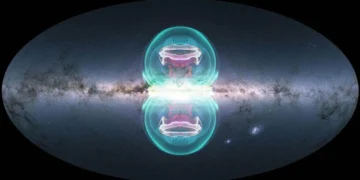The Milky Way, our home galaxy, has long been thought of as a relatively calm spiral system. However, a recent discovery has revealed two enormous, mysterious structures extending 50,000 light-years above and below the galactic center. These vast formations, known as the Fermi and eROSITA bubbles, suggest that the heart of our galaxy has undergone dramatic, energetic outbursts in its past.
Fermi Bubbles: Unveiling Gamma-Ray Structures
The first indication of these gigantic structures came in 2010, when NASA’s Fermi Gamma-ray Space Telescope detected two large gamma-ray emitting bubbles. These bubbles, stretching 25,000 light-years in each direction from the Milky Way’s core, were unlike anything seen before.
Scientists initially debated their origin, as gamma-ray emissions typically indicate high-energy astrophysical processes. The shape and intensity of the Fermi bubbles suggested they were created in a powerful event—possibly linked to activity from Sagittarius A*, the supermassive black hole at the center of the Milky Way.
Since black holes are known for their ability to devour matter, the discovery of outward-extending bubbles was intriguing. The prevailing hypothesis suggested that Sagittarius A* had experienced a violent energy outburst millions of years ago, releasing high-speed particles that inflated these bubbles.
eROSITA Bubbles: A Bigger Picture Emerges
A decade later, in 2020, the eROSITA X-ray telescope (aboard the Spectrum-Roentgen-Gamma mission) provided another stunning revelation. It detected two even larger X-ray emitting bubbles, extending nearly 45,000 light-years above and below the galaxy. These structures were larger than the previously discovered Fermi bubbles and shined in X-rays rather than gamma rays.
The eROSITA bubbles had a shockwave signature, which indicated they had been inflated by an extremely powerful event. Their detection provided a missing link, as scientists could now compare the size, energy, and emission spectra of both the Fermi and eROSITA bubbles.
The relationship between the two bubble sets suggested that a single, powerful event, likely driven by Sagittarius A*, had expanded in different phases. While the Fermi bubbles indicated an earlier high-energy ejection of cosmic rays, the eROSITA bubbles showcased a later, shockwave-driven expansion of hot gas.
The Supermassive Black Hole Outburst Hypothesis
The leading theory suggests that these enormous structures formed due to an intense jet of material erupting from Sagittarius A* about 2.6 million years ago. This eruption lasted roughly 100,000 years and released an immense amount of energy into the galaxy.
Simulations conducted at the University of Michigan confirmed that such an event could generate both the Fermi and eROSITA bubbles. The presence of a microwave haze around the galactic center further supported this black hole-driven outflow.
This scenario aligns with observations of other galaxies, where supermassive black holes are known to release jets that influence galactic evolution. The energy released in such events is powerful enough to push away surrounding gas, regulate star formation, and inflate massive structures like these bubbles.
Alternative Hypotheses: Starburst Winds
Another possibility is that these bubbles resulted from an intense burst of star formation (a “starburst” event). Such an event would drive supernova explosions that generate strong winds, capable of forming these large-scale structures.
Some galaxies have supernova-driven outflows that create large bubble-like formations. The energy requirements for this process, however, do not match the scale of the Fermi and eROSITA bubbles.
While supernovae can cause smaller-scale galactic winds, the sheer size and symmetry of these bubbles make the black hole outburst hypothesis more likely.
Why Is This Discovery Important?
1. Understanding How Black Holes Influence Galaxies
The Fermi and eROSITA bubbles prove that Sagittarius A was active in the past*. Black holes do not just pull in matter—they also expel enormous amounts of energy, which in turn shapes their galaxies.
Observations of distant galaxies show similar bubble-like structures around active galactic nuclei. The Milky Way’s bubbles suggest that even in “quiet” galaxies, black holes may experience periodic outbursts.
These findings challenge the previous belief that our galaxy’s central black hole has remained dormant for most of its history. Instead, the bubbles indicate that Sagittarius A had an active past*, influencing the evolution of the Milky Way’s core.
2. The Role of Cosmic Rays and Galactic Evolution
These bubbles provide insight into how cosmic rays—high-energy particles—travel through space and impact their surroundings.
Cosmic rays within the Fermi bubbles interact with gas in the galaxy, producing detectable gamma-ray emissions. The eROSITA bubbles’ X-ray emission reveals heated gas being expelled from the Milky Way.
3. Insights into the Milky Way’s Past and Future
This discovery provides a “galactic fossil record” that helps scientists reconstruct past events and predict future activity.
The Fermi bubbles suggest a short but dramatic energy release, while the eROSITA bubbles indicate longer-lasting shockwaves. Studies of similar structures in other galaxies support the idea that such bubbles are common features in galactic evolution.
By piecing together these cosmic clues, scientists can better understand the life cycle of galaxies, including whether the Milky Way will experience similar outbursts again.
Future Research and Next Steps
Scientists are now exploring several key questions:
- What triggered Sagittarius A‘s outburst?*
- Could other galaxies with central black holes exhibit similar behavior?
- How do these bubbles interact with surrounding galactic structures?
Upcoming telescopes, such as the James Webb Space Telescope (JWST) and future X-ray observatories, will provide even clearer images of these bubbles, helping to refine existing models and uncover new insights.
Conclusion
The discovery of the Fermi and eROSITA bubbles has revolutionized our understanding of the Milky Way, revealing that our galaxy has a far more dynamic and explosive past than previously imagined. These massive structures serve as evidence of past black hole activity, cosmic ray propagation, and the interplay between supermassive black holes and galactic evolution.
Reference:
Space Bubbles: The Deflection of Solar Radiation Using Thin‐Film Inflatable Bubble Rafts



















